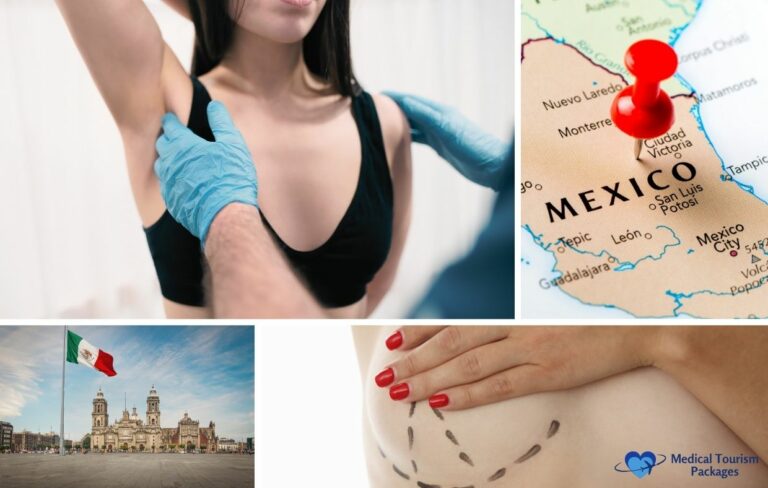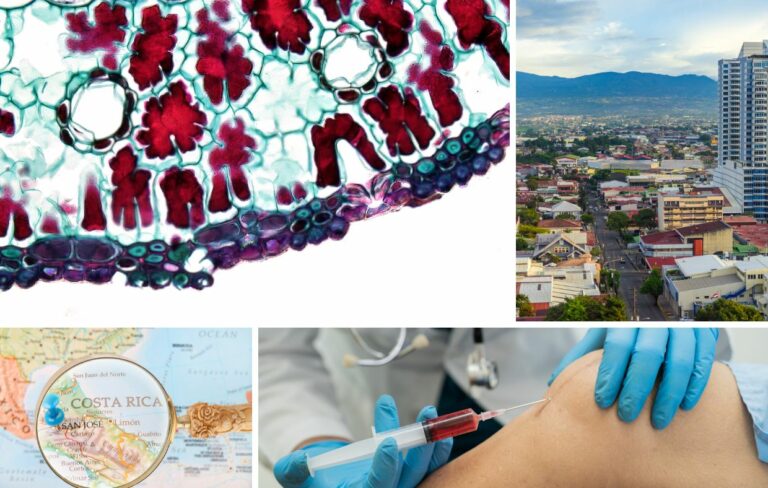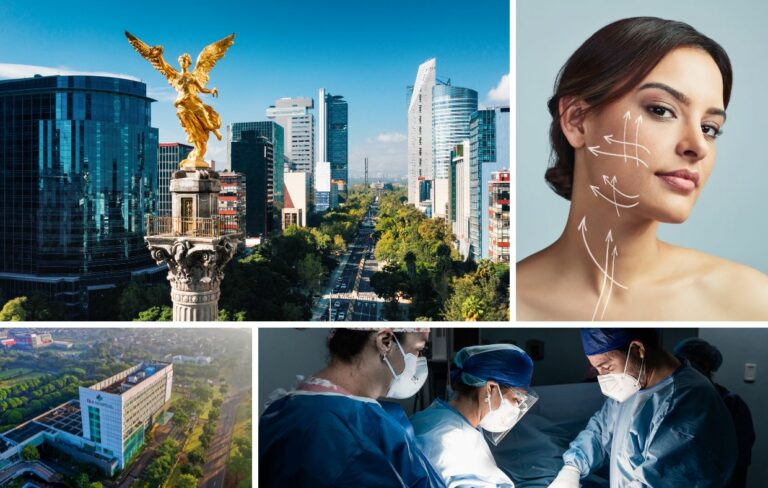Book Appointment Now
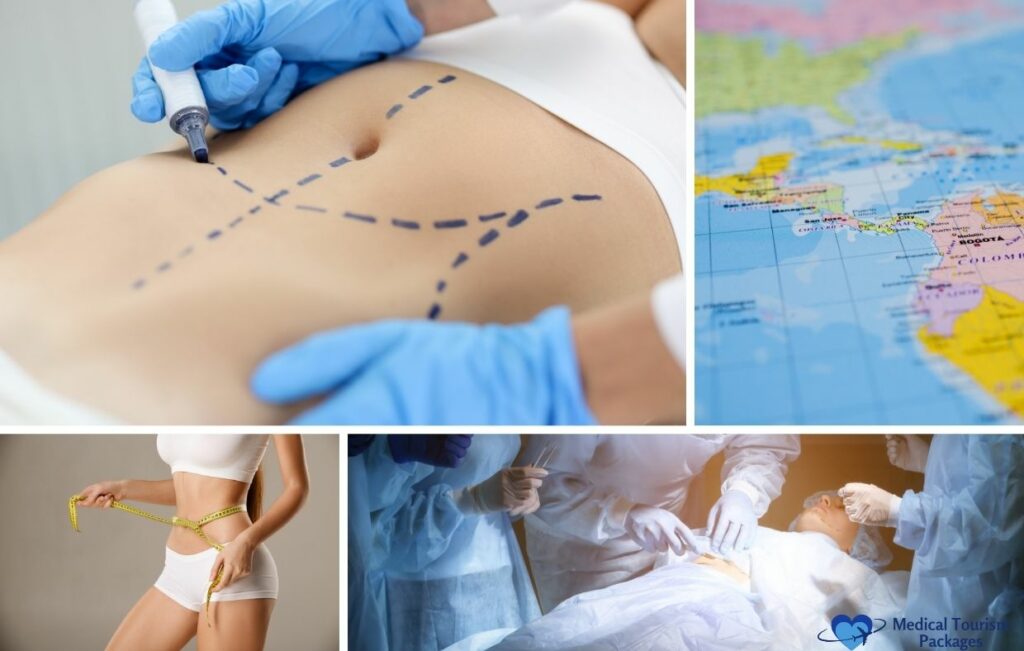
Abdominoplasty (Tummy Tuck Surgery) in Latin America: Complete Cost Guide, Top Destinations, and Safety Standards
Every year, thousands of patients travel to Latin America for abdominoplasty. They find skilled surgeons, modern facilities, and significant cost savings compared to the United States or Canada. This cost difference has made countries like Mexico, Colombia, and Brazil leading destinations for cosmetic surgery tourism.
Abdominoplasty removes excess skin and fat from the abdomen while tightening weakened muscles. Patients typically seek this surgery after significant weight loss, pregnancy, or aging. A full abdominoplasty costs $10,000-20,000 in the US but runs $3,000-8,000 in top Latin American surgical centers.
However, lower prices don’t tell the complete story. Quality varies significantly between facilities and surgeons. Language barriers can complicate care. Travel logistics add complexity to recovery. This guide examines the practical realities of getting abdominoplasty in Latin America with transparent cost comparisons, safety credentials, and destination-specific considerations.
What Is Abdominoplasty, and Why Is Latin America Popular?
Abdominoplasty addresses excess abdominal skin, stubborn fat deposits, and separated abdominal muscles. Surgeons remove loose skin, tighten the muscle wall, and reposition the belly button. The surgery targets problems that diet and exercise cannot fix.
Why Latin America dominates body contouring:
Colombian clinics alone perform tens of thousands of abdominoplasties annually, creating unmatched surgical expertise through sheer procedure volume. Latin America’s cultural acceptance of aesthetic surgery has eliminated stigma and fostered sophisticated patient care infrastructure. Major hubs now offer dedicated recovery houses with 24/7 bilingual nursing support specifically designed for international patients. The economic impact is substantial. Medical tourists spent $500 million in Colombia in 2022 alone, driving continuous quality improvements across the industry.
The cost-effectiveness threshold sits at approximately $7,061, which is the point where total costs (surgery, travel, accommodations, recovery) become financially advantageous versus domestic options.
Top Latin American Countries for Tummy Tuck Surgery
Five countries lead the region in abdominoplasty expertise, each offering distinct advantages in pricing, volume, and infrastructure.
Brazil leads in procedure volume with 85,000+ annual abdominoplasties and attracts 15,000-20,000 foreign patients. São Paulo and Rio de Janeiro serve as the primary hubs. Brazilian surgeons pioneered modern body contouring techniques and operate the region’s largest training programs.
Colombia has become the medical tourism capital, performing 60,000+ procedures annually and welcoming 25,000-30,000 international patients. Medellín, Bogotá, Cali, and Cartagena offer world-class facilities with a 98.2% patient satisfaction rate.
Mexico performs 45,000+ abdominoplasties yearly and sees the highest foreign patient volume at 35,000-40,000 annually. Tijuana, Guadalajara, and Cancún provide convenient access for US patients, with most surgeons offering bilingual services.
Costa Rica completes 8,000+ procedures annually, attracting 4,000-6,000 international patients to San José and Escazú. The country emphasizes JCI-accredited facilities and maintains strong regulatory oversight.
Panama performs 5,000+ procedures yearly with 2,000-3,000 foreign patients. Panama City concentrates US-trained surgeons and modern infrastructure in a compact, accessible location.
Cost Breakdown by Country
Surgical costs vary significantly across Latin America based on market dynamics, accreditation standards, and surgeon expertise.
| Country | Price Range | Savings vs US | Key Cost Factors |
| Mexico | $3,500-$7,000 | 55-75% | Border proximity increases competition; resort destinations charge premium |
| Colombia | $3,000-$6,000 | 60-80% | Medellín offers lowest rates; high-volume surgeons maintain competitive pricing |
| Brazil | $4,000-$8,000 | 50-70% | São Paulo and Rio command premium; renowned surgeons charge near-European rates |
| Costa Rica | $5,000-$8,000 | 45-60% | JCI accreditation increases costs; premium positioning strategy |
| Panama | $4,500-$7,500 | 50-65% | US-trained surgeons charge premium; smaller market limits competition |
What affects pricing:
- Clinic location: Tourist destinations like Cancún or Cartagena charge 20-40% more than medical districts
- Facility accreditation: JCI-accredited facilities command premium pricing but provide validated safety standards
- Surgeon volume: High-volume surgeons (200+ procedures annually) often charge less due to efficiency
- Combined procedures: “Mommy Makeovers” bundling tummy tuck with breast surgery offer 15-25% savings versus separate procedures
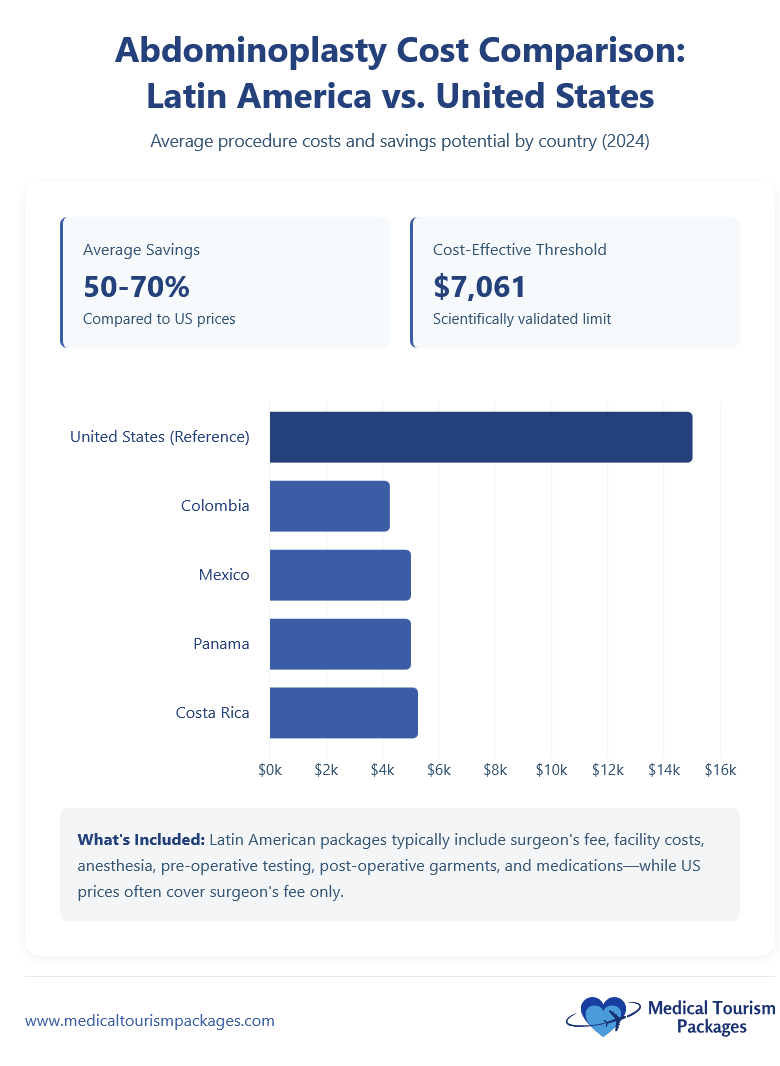
Types of Tummy Tuck Procedures
Different abdominoplasty techniques address varying degrees of skin laxity and body contouring goals, with corresponding recovery timelines and complication rates.
| Procedure Type | Best For | Incision Size | Recovery Time | Complication Rate | Typical Cost |
| Full Abdominoplasty | Excess skin above and below navel; muscle separation | Hip-to-hip | 4-6 weeks | 3.1% (isolated) | Base price |
| Mini Tummy Tuck | Lower abdomen only; minimal excess skin | Shorter incision | 2-3 weeks | ~2% | 20-30% less |
| Extended Tummy Tuck | Post-bariatric patients; circumferential laxity | Extends to back | 6-8 weeks | ~5% | 30-50% more |
| With Liposuction | Multiple area contouring | Hip-to-hip + lipo sites | 4-6 weeks | 3.8% | Add $1,000-2,000 |
| Mommy Makeover | Comprehensive post-pregnancy transformation | Multiple sites | 6-8 weeks | 6.8% | $5,000-12,000 total |
TULUA Technique (popular in Colombia): Preserves blood supply by avoiding extensive undermining, enabling safe unrestricted liposuction during abdominoplasty. Benefits include reduced necrosis risk, lower seroma rates, and more aggressive single-stage contouring.
Finding Qualified Surgeons
Selecting the right surgeon is the most critical decision in your medical tourism journey. Here’s how to verify credentials and evaluate expertise across different Latin American countries.
Required Certifications by Country
| Country | National Board | Requirements | International Affiliations |
| Mexico | CMCPER | Approved residency + comprehensive exams | FILACP, ISAPS |
| Colombia | SCCP | 3-4 years plastic surgery residency beyond general surgery | FILACP, ISAPS, often ASPS |
| Brazil | SBCP | 3-5 years residency (highly competitive, <5% acceptance) | FILACP, ISAPS (gold standard) |
Credential Verification Checklist
- Confirm national board certification via official registry (CMCPER, SCCP, or SBCP website)
- Check ISAPS membership at isaps.org (requires rigorous credentialing beyond basic licensure)
- Verify high-volume experience: Ask annual abdominoplasty case volume (100+ procedures yearly indicates expertise)
- Review specialization: Body contouring should comprise 60%+ of practice
- Examine before/after galleries: Review 20-30 cases matching your body type on ASPS/ISAPS member galleries
Essential Consultation Questions
- What abdominoplasty technique do you recommend for my anatomy and why?
- How many abdominoplasties do you perform annually?
- Will you repair my entire rectus sheath or just lower abdomen?
- Who administers anesthesia? (Board-certified anesthesiologists provide safest care)
- What is your complication rate for this specific procedure?
- What are realistic recovery timelines for my situation?
- How do you handle complications if they arise?
- What are your protocols for medical screening and comorbidity assessment?
Step-by-Step Medical Tourism Process
Understanding the complete timeline helps you plan effectively and avoid surprises. Here’s what to expect from initial planning through final recovery.
1. Planning & Financial Preparation (2-6 months before)
Budget 20-30% beyond your surgical cost for potential complications or extended stays. Understand that US, Canadian, and European insurance typically excludes cosmetic procedures performed abroad along with any related complications. Payment options include cash, major credit cards, wire transfers, medical tourism financing at 8-18% APR, or HSA/FSA accounts if the procedure qualifies as medically necessary.
2. Initial Consultation (Virtual or in-person)
Surgeons assess candidacy through medical history review, physical examination, comorbidity screening (diabetes, hypertension, BMI, smoking status), and determine appropriate technique. High-risk patients may need medical clearance from primary care physicians.
3. Surgery Day
Procedures take 2-3 hours for isolated abdominoplasty, 4-6 hours for Mommy Makeovers. Modern techniques like TULUA preserve blood supply while enabling aggressive contouring.
4. Recovery in Latin America (10-14 days mandatory)
Patients stay near surgical facility with specialized post-operative care in recovery houses offering private rooms, 24/7 bilingual nursing, medication administration, prepared meals, and scheduled follow-up transportation. Surgeons see patients on days 1, 3, 7, and 10-14. Drains removed when output drops below 30cc/day.
5. Travel Home & Follow-up
Air travel safe after 10-14 days. Book aisle seats, walk hourly, wear compression garments, arrange wheelchair assistance. Continue care through telemedicine (weekly photos for 3 months) and schedule local plastic surgeon for 6-week in-person follow-up.
Recovery Timeline
Understanding the recovery phases helps you plan time off work, arrange support, and set realistic expectations for your return to normal activities.
| Timeframe | Location | Activity Level | Key Milestones | Restrictions |
| Days 1-2 | Recovery house | Minimal; assisted bathroom trips | 24/7 nursing monitoring, medication management | Remain bent forward; compression garments 24/7 |
| Days 3-14 | Latin America (mandatory) | Short walks increasing daily | Surgeon follow-ups (days 3,7,10,14); drain removal | No lifting, bending, or overhead reaching |
| Weeks 2-6 | Home | Light household tasks by week 3; desk work week 2-3 | Gradually straighten posture; walk 30-45 min daily | No lifting >10 lbs; no core exercises until week 8 |
| 6-12 months | Home | Full activities after clearance | Final contour emerges; scars fade | Maintain weight stability; monitor for complications |
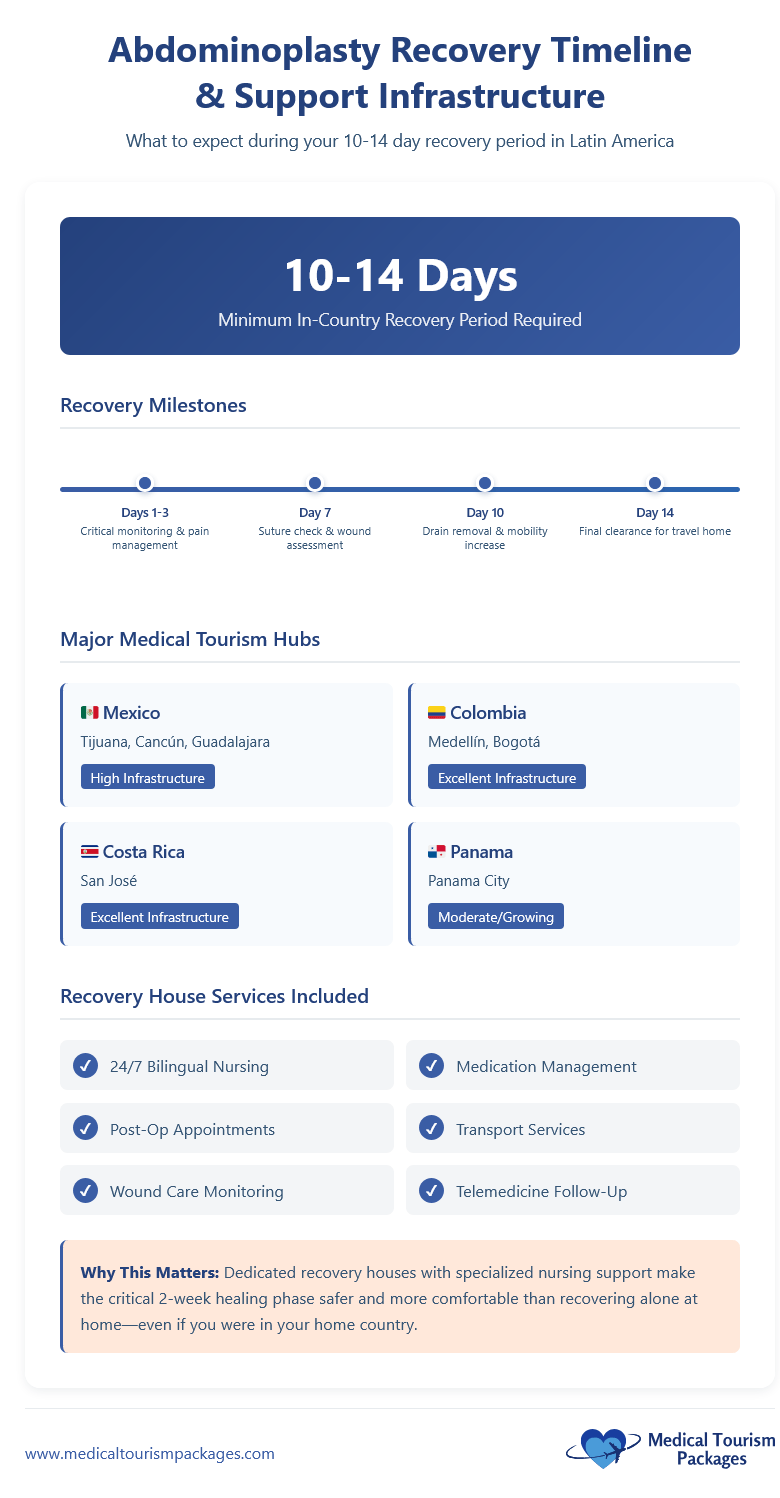
Advantages of an Abdominoplasty in Latin America
Cost-effectiveness validated through clinical models: Studies using quality-adjusted life years (QALY) confirm Latin American procedures deliver similar outcomes at substantially lower costs. Most patients save $4,000-12,000 even after travel expenses.
High-volume expertise: High-volume surgeons demonstrate complication rates below 5%, matching or exceeding US academic centers. Colombian and Brazilian surgeons developed innovations like TULUA and VASER High Definition that influenced global practice.
Recovery tourism infrastructure: Medellín, Cartagena, and Rio offer ocean-view recovery suites with gourmet meals and carefully paced excursions during weeks 2-3. Economic multiplier effect: Each medical tourism dollar generates $1.40 in related economic activity.
Geographic convenience: Mexico sits 20 minutes to 3.5 hours from major US cities. Time zones align within 0-3 hours, facilitating telemedicine. US citizens receive tourist visas on arrival for 90-180 days in most Latin American countries.
Risks and Disadvantages of an Abdominoplasty in Latin America
Distance and follow-up care: Managing post-operative concerns after returning home may require local providers unfamiliar with your procedure. Establish a relationship with a local plastic surgeon before traveling and obtain complete operative reports.
Language support: Most medical tourism facilitators provide translation services throughout your care journey.
Safety Standards by Country
Regulatory oversight and certification requirements vary across Latin America, affecting quality assurance and patient protection.
| Country | Regulatory Body | Certification Standards | Accreditation | Quality Notes |
| Mexico | COFEPRIS (federal) + CMCPER (board) | Basic facility licensing + board certification | JCI/ACI in premium facilities (Galenia Hospital Cancún) | Wide quality spectrum; patient due diligence critical |
| Colombia | SCCP certification | Rigorous residency + exams; continuing education | JCI in select facilities (Clínica Imbanaco Cali) | Major cities concentrate high-quality facilities; 6.2% complication rate in high-volume centers |
| Brazil | SBCP certification | Most competitive training (<5% acceptance); 3-5 year residencies | Limited facility accreditation outside academic centers | Exceptional surgeon training; prioritize surgeon credentials over facility appearance |
International accreditation significance: JCI/ISAPS/ASPS membership indicates commitment to global standards. Studies show measurably lower complication rates in accredited facilities due to systematic quality improvement processes.
Specialized Medical Tourism Clinics
Mexico:
- Galenia Hospital (Cancún), JCI accredited, dedicated plastic surgery infrastructure
- Marroquín & Sandoval Institute (Tijuana), 20 minutes from San Diego
- Innovare Hospital (Guadalajara), Lower costs than border cities
Colombia:
- Clínica Imbanaco (Cali), JCI accredited, tertiary reference center
- Fundación Santa Fe de Bogotá, Highest safety standards, premium pricing
Costa Rica:
- Multiple JCI-accredited facilities in San José, Premium positioning, 30-50% higher costs
Maintaining Results Long-Term
Result longevity: Abdominoplasty produces permanent changes when patients maintain weight within 10-15 pounds of surgical weight. Results last 15-20+ years before aging effects become noticeable. Pregnancy stretches tissues and often requires revision.
Maintenance requirements:
Maintaining stable weight through balanced nutrition and exercise is essential for preserving your results. Protect scars from sun exposure using SPF 50+ for 12-18 months post-surgery. After receiving clearance at 8-12 weeks, strengthen your core with appropriate exercises. Schedule periodic follow-ups annually to monitor your results. If you plan to have children, delay pregnancy until after abdominoplasty, as pregnancy stretches tissues and often necessitates revision surgery. Address weight gain promptly—losing 5 pounds is far easier than losing 30 pounds later.
Long-term satisfaction: 85-95% of patients report satisfaction 5-10 years post-operatively, even those who experienced minor complications. The aesthetic improvements provide lasting psychological benefits that exceed temporary recovery discomfort.
Is an Abdominoplasty in Latin America Right for You?
Best suited for patients who:
- Seek significant cost savings without compromising surgeon qualifications
- Want comprehensive body transformation in single surgery
- Feel comfortable with international travel and cultural adaptation
- Can remain abroad for 2+ weeks of initial recovery
- Have realistic expectations about outcomes, scarring, and recovery demands
Success factors:
Verify surgeon credentials through national board registries and ISAPS membership. Confirm facility accreditation, with JCI preferred for risk-averse patients. Budget for complications and extended stays beyond your planned timeline. Arrange local follow-up care before traveling, and set aside emergency funds representing 25-35% beyond your surgical costs.
For the right patient with thorough preparation, Latin American abdominoplasty delivers exceptional value. The combination of affordability, expertise, and innovation creates transformation opportunities that wouldn’t otherwise exist. However, the decision demands careful evaluation of your circumstances, risk tolerance, and ability to navigate medical tourism’s complexities.
Ready to Start Your Medical Tourism Journey?
Navigating international surgery requires expert guidance. Medical Tourism Packages connects you with vetted, board-certified surgeons across Latin America, handles logistics from consultation to recovery, and provides 24/7 support throughout your journey. Our facilitation services eliminate the guesswork and risk from medical tourism, ensuring you receive quality care at transparent prices.
Contact Medical Tourism Packages today to discuss your abdominoplasty goals with our experienced coordinators. We’ll match you with the right surgeon, arrange your complete travel package, and guide you through every step. Transform your body with confidence—let us handle the details while you focus on your results.
Frequently Asked Questions
How much can I actually save with abdominoplasty in Latin America?
Surgery fees typically run $3,000–$8,000 in Latin America versus $10,000–$20,000 in the U.S. Colombia averages $3,000–$6,000 (≈60–80% savings) and Mexico $3,500–$7,000 (≈55–75%). Even after travel, lodging, and recovery services, most patients still save about $4,000–$12,000 overall. The cost-effectiveness threshold is ≈$7,061—the point where your all-in trip cost becomes financially advantageous compared with domestic options.
How long do I need to stay in Latin America after surgery?
Plan to remain near your surgical facility for 10–14 days of mandatory post-operative care. You’ll typically stay in a recovery house with 24/7 bilingual nursing and attend follow-ups on days 1, 3, 7, and 10–14. Air travel is considered safe after this window; book an aisle seat, walk hourly during the flight, wear compression garments, and request wheelchair assistance at the airport.
How do I verify a surgeon is actually qualified?
Confirm national board certification using official registries—CMCPER (Mexico), SCCP (Colombia), or SBCP (Brazil)—and check ISAPS membership, which adds credentialing beyond basic licensure. Ask about annual case volume (100+ abdominoplasties/year suggests expertise) and whether body contouring is ≥60% of their practice. Review 20–30 before/after cases that match your body type via ASPS/ISAPS member galleries.
What questions should I ask during my consultation?
Ask which abdominoplasty technique fits your anatomy and why, the surgeon’s yearly volume, whether the entire rectus sheath will be repaired or just the lower abdomen, and who provides anesthesia (board-certified anesthesiologists are safest). Also request their complication rate for this procedure, a realistic recovery timeline for your case, how they manage complications, and their medical screening/comorbidity protocols.
Will my insurance cover complications if something goes wrong?
Insurance in the U.S., Canada, and Europe usually excludes cosmetic procedures performed abroad and related complications. Budget an extra 20–30% of your surgical cost for potential complications or extended stays. If issues occur after you return, expect U.S. ER visits of ~$500–$3,000 and revision surgeries of ~$3,000–$10,000. Establish a relationship with a local plastic surgeon before traveling and secure complete operative reports.
What’s the difference between a full tummy tuck and a mini tummy tuck?
A full abdominoplasty treats excess skin above and below the navel, often with muscle repair, uses a hip-to-hip incision, involves ~4–6 weeks of recovery, and has an ≈3.1% complication rate. A mini tummy tuck targets only the lower abdomen, uses a shorter incision, typically requires ~2–3 weeks of recovery, carries ~2% complication risk, and costs about 20–30% less than a full procedure.
How do I know if a facility meets international safety standards?
Look for JCI (Joint Commission International) accreditation, which signals adherence to global safety standards and ongoing quality improvement. Examples include Galenia Hospital in Cancún (Mexico), Clínica Imbanaco in Cali (Colombia), and several facilities in San José, Costa Rica. JCI-accredited centers may cost more but provide validated systems that reduce risk.
When can I return to normal activities after surgery?
Days 1–2: minimal activity, short assisted bathroom trips, and a slightly bent-forward posture. Weeks 2–6: light household tasks by week 3 and return to desk work around weeks 2–3; avoid lifting >10 lb and core exercises until about week 8. Months 6–12: resume full activities with provider clearance as final contour refines and scars fade.

